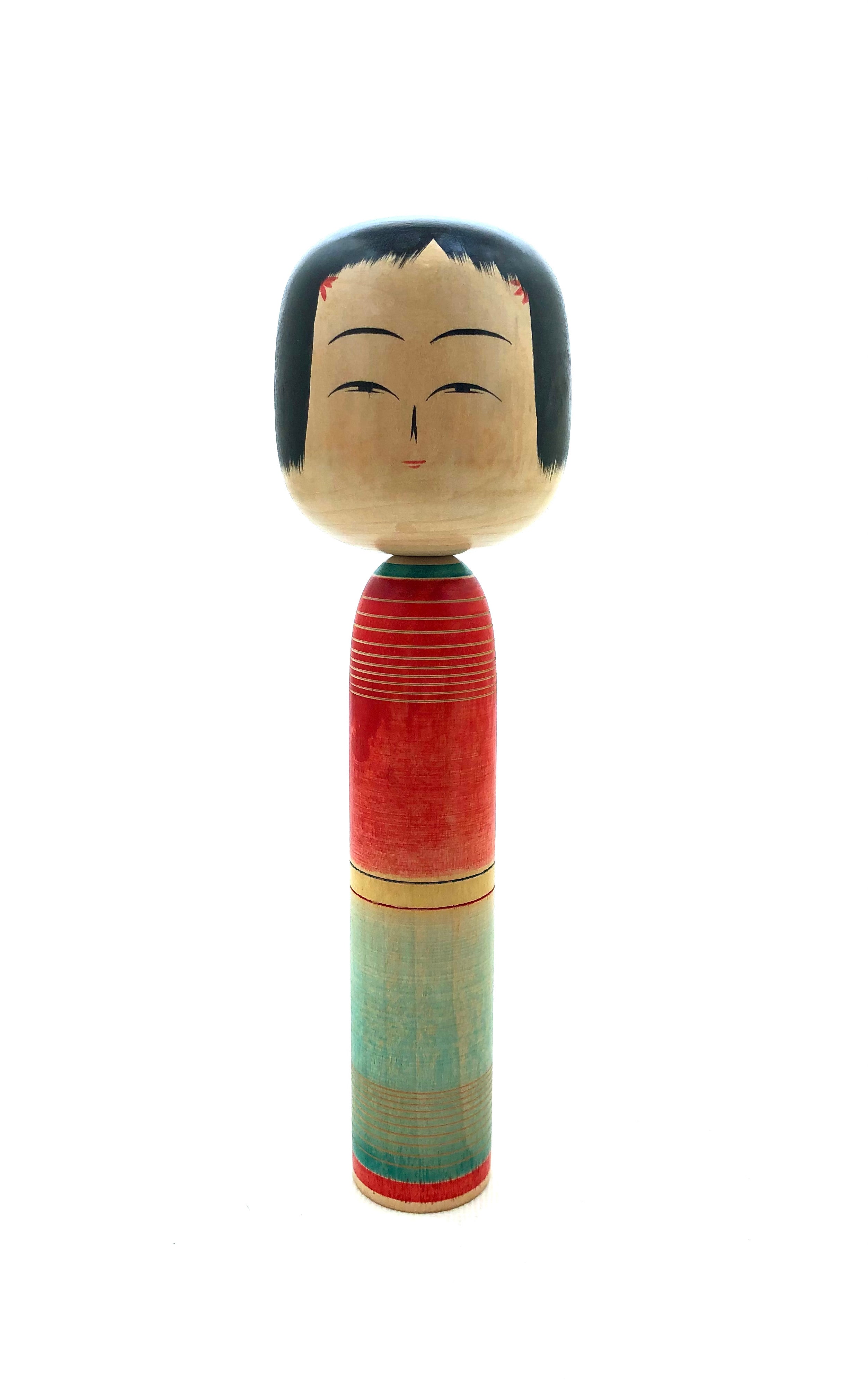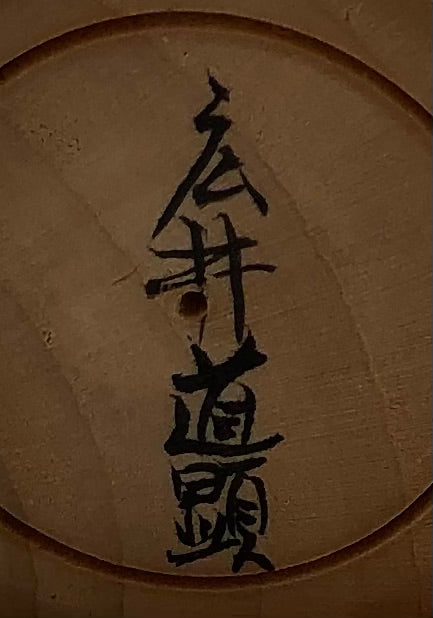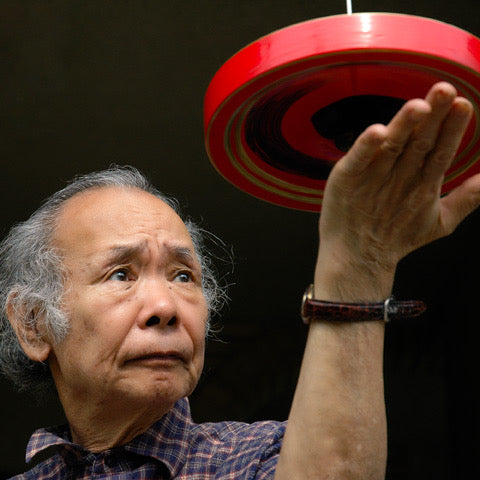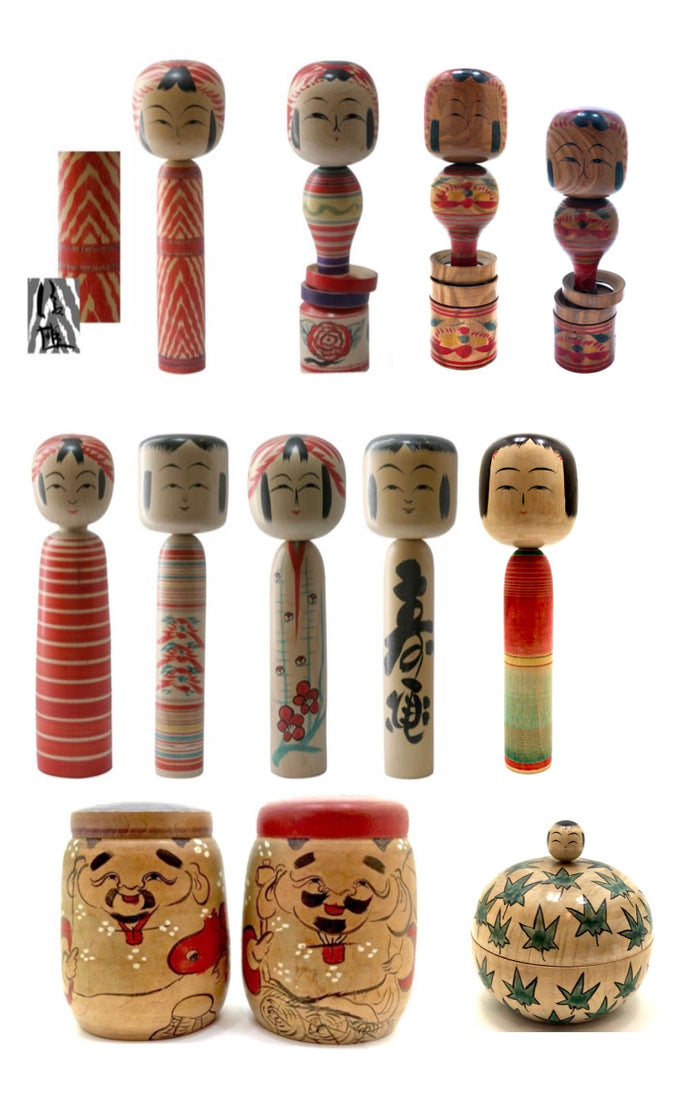


Vintage Traditional Rainbow Tougatta-Kei Kokeshi by Hiroi, Masaaki
Dimensions: 12-0”h
Tougatta dolls are thought to be the oldest family members of the Traditional school. They originated in the Tougatta Onsen in the Miyagi Prefecture and were subsequently being produced also at Aone Onsen, and the cities of Sendai, and Izumi. The Tougatta style is easily found by collectors in an interesting range of variations.
Shown is an extremely rare Kokeshi by an artist that made a limited number of dolls, for he specialized and had a passion for toys and spinning tops, (Koma) where his reputation has lasted through today. Hiroi did not live in the Miyagi Prefecture where the Tougatta Kokeshi originated, but this lathe-turned doll was inspired by the Tougatta Family having a narrow, columnar body that tapers at the shoulders to a head that is wider than the rest of the body. It has bangs split in two with side fringes with a shaggy overall hairline and thin narrow eyes and a split nose. The body is banded in rainbow colors, (which are very rare), and throughout the body, along with shallow carved line work giving texture to the doll. This treatment is a circular-style treatment that is a very meticulous method known as ‘Rokoru Moyo’. The doll is signed in the script by the artist on the bottom of the figure.
Condition: Excellent, original condition, with no fading or loss of color and consistent with age and standards of collectible Folk Art. All details are perfect and as crafted.
NOTE: Hiroi-san, (1935-2019) and lived in Oshima, Kōtō Ward (Tokyo) with his mother, father, and three siblings and was driven out of his home by the fires from air raids, first to Kuramae, then Roppongi and Shirokane, for which they barely escaped with their lives. It was also because of the war that he began to make Kokeshi, which were originally considered toys, toy action figures, and tops after his father gave me a foot-powered lathe so he could make tops and other things to play with and to entertain children.
“Cutting-edge technology is fun, but it’s a pity if children become absorbed only in those toys. There are traditional toys and traditional ways to play in Japan. One of them is the spinning top, (Koma). I am sad to see so many old toys become obsolete around the world. I want to make people who buy my toys, laugh, and make toys that anyone, old and young, men and women can enjoy”. MH

Japanese Traditional Kokeshi
Tougatta-Kei (Family)
Prefecture: Miyagi
Origin:
Tougatta dolls are considered the oldest family members of the Traditional school. They originated in the Tougatta Onsen in the Miyagi Prefecture and were subsequently produced at Aone Onsen and the cities of Sendai and Izumi. In the 1960s, Togatta craftsmen founded the Tougatta Kiji Union, a cooperative that gained the rights for reserved wood use from the Japanese Ministry of Forestry. Collectors easily find the Tougatta style in an interesting range of variations.
Collector's note – characteristics/painting style:
Tougatta dolls are easily recognized by their narrow, columnar body shapes, tapering at the shoulders, to a head that is wider than the rest of the doll, and more angular than round. The head is a squeeze-in type, and it is covered with a painting of a chrysanthemum. Most Tougatta dolls have split bangs (Hachi), with side fringes, crescent-shaped double-lidded eyes (many of which have arched brows), and a split nose or cat-type nose. Several have paintings of chrysanthemums (Kiku), plums (Ume), and irises (Ayame), usually in very stylized designs. The dolls decorated with plum branches and blossoms are associated with Aone Onsen. There is also a group that has ‘banded’ bodies primarily in red with some green. These are decorated in a circular-style painting known as Rokoru Moyo, which is done as the doll is turned on the lathe. The most collectible type is the Tougatta Mokuma style, in which the body or kimono is intricately painted with a detailed and variable wood grain pattern.
NOTE: The rare Tougatta Yamiyo dolls are created with loose rings circling the waists. Carved from the same wood as the body- it is a very meticulous method! It is also seen on Yajirou and Tsuchiyu dolls, though just as rare.

Leading Craftsmen:
Agatsuma, Shozo, 1932- No additional published information
Saito, Ryosuke, 1925-2015 - No additional published information
Sato Fumio, 1923-1986. Lineage: Tougatta lineage Master: Sato Bunsuke Disciples: Sato Hidehiro / Kobayashi Sadao / Ohata Hideo. Born in Togatta-Shinchi as the eldest son of Sato Ushizo and Tamayo, woodworkers in Togatta-Shinchi. He trained in woodworking under Sato Bunsuke. In 1940 Sato-san learned how to turn kokeshi dolls and toys. Fumio was said to have both the Bunsuke and Ushizo characters inside him and was always caught in a conflict between his two mentors from the Tougatta and Hijiori families.
Sato, Bunkichi, 1922-2008 - No additional published information
Sato, Kouichi - No additional published information
Sato, Masairo, 1938- No additional published information
Sato, Nirio, 1948, (Tougatta, Miyagi) - Master: Sato, Teruo
Sato, Teruo, 1919 - (Tougatta) -Master: Sato Seisuke
Sato, Tomio - No additional published information
Sato, Yoshiaki, (Tougatta, Miyagi) - Master: Sato, Teruo
Sato, Ushizo , Master - (Tougatta, Miyagi Spa)
Nagao, Masayoshi, 1931-2001, (Sendai, Miyagi) - Master: Sato, Mamoru
Wagamatsu, Yoshio, 1932 (Aone, Miyagi) - Master: Wagatsuma, Kichisuke
Explore & Learn More about Tougatta-Kei (Family)